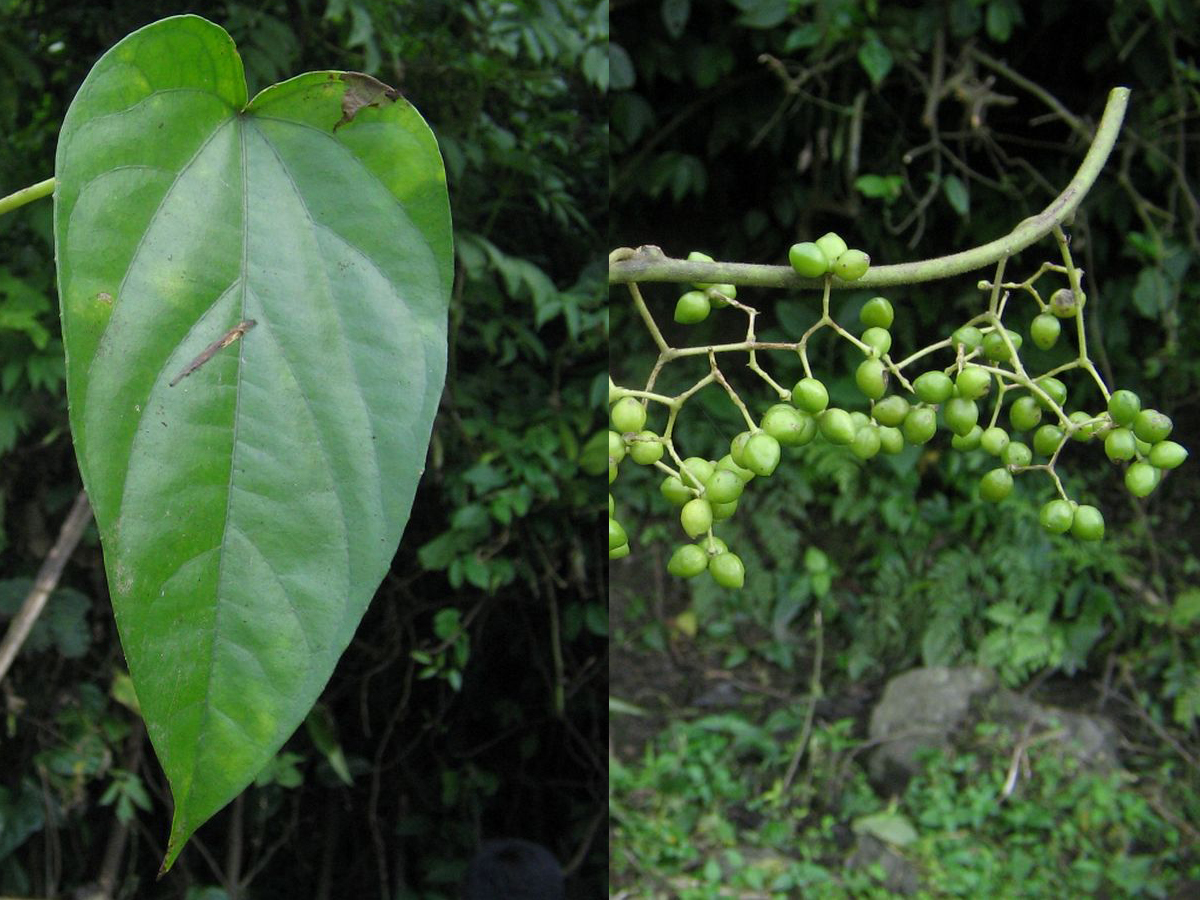ເລກລຳດັບທີ: 2337
ລະດັບການຮວບຮວມຂໍ້ມູນ: ຂໍ້ມູນພື້ນຖານ
ປັບປູງຄັ້ງລ່າສຸດ: N/A
ຜັກໜັງ
Pak Nung
Parabaena sagittata Miers ex Hook.fil. & Thomson.
ພືດ
ພືດເຄືອ
ພືດເຄືອ (ບໍ່ມີເນື້ອໄມ້)
×
ຊື່ທ້ອງຖີ່ນ:
ຊື່ລາວ: ຜັກໜັງ, ຜັກໝາມ.ຊື່ໄທ: ຜັກໜັງ, ຜັກຄຸ່ຍແບລະປີ, ເໝາະ, ຜັກໜັງ, ບະພວກ, ຜັກກ່ວາຍ.ຊື່ຈີນ: 连蕊藤ຊື່ຫວຽດ: Gươm điệp
ຊື່ພ້ອງ
:
Parabaena ferruginea Miers
Parabaena heterophylla Miers
Parabaena oleracea Miers
Parabaena racemosa Gagnep.
Parabaena heterophylla Miers
Parabaena oleracea Miers
Parabaena racemosa Gagnep.
ຊື່ສະກຸນ:
Menispermaceae
ຊະນິດໃກ້ຄຽງ:
ບັນຍາຍລັກສະນະທາງພືດສາດ:
ລຳຕົ້ນເປັນລຳເລືອເກາະກາຍຕາມຕົ້ນໄມ້, ກົມ, ທຸກພາກສ່ວນຂອງລຳຕົ້ນມີຢາງສີຂາວ, ສີຂຽວ. ໃບດ່ຽວ, ອອກຮຽງສະຫຼັບ, ຮູບຫອກ, ຮູບສາມຫຼ່ຽມ ຫຼື ຮູບຫົວໃຈ, ກົກໃບຮູບລູກສອນ, ຂອບລຽບ, ປາຍແຫຼມ, ແຜ່ນໃບໜາຄ້າຍຄືໜັງ, ຜິວໃບດ້ານເທິງສີຂຽວເຂັ້ມ, ກ້ຽງ, ຜິວໃບດ້ານລຸ່ມສີຂຽວອ່ອນ, ມີຂົນສັ້ນກະຈາຍຫ່າງໆ, ໃບ ແລະ ຍອດອ່ອນມີຂົນສີນ້ຳຕານປົກຄຸມຢ່າງໜາແໜ້ນ. ຊໍ່ດອກອອກຕາມງ່າມໃບ, ສີຂາວປົນສີເຫຼືອງ. ດອກຍ່ອຍມີຈຳນວນຫຼາຍ, ສີຂາວ, ມີກິ່ນຫອມ. ໝາກຮູບກົມ ຫຼື ຮູບໄຂ່, ສີຂຽວ. ແກ່ນຮູບກົມ.
ນິເວດວິທະຍາ
ເຂດກະຈາຍພັນທົ່ວໂລກ:
N/A
ເຂດກະຈາຍພັນໃນລາວ
:
ເຂດກະຈາຍພັນຕາມພູມສັນຖານ
:
ສະເພາະຖິ່ນໃນລາວ:
N/A
ຮຸກຮານ
:
N/A
ສະຖານະພາບການອະນູຮັກ IUCN
:
N/A
ສະຖານະພາບການອະນຸຮັກແຫ່ງຊາດລາວ
:
N/A
ການນຳໃຊ້
ປະເພດການນຳໃຊ້:
ອາຫານ
ບັນຍາຍການນຳໃຊ້:
ເປັນອາຫານ: ໃບ ແລະ ຍອດອ່ອນ ກິນສົດ, ຫຼວກ ຫຼື ຕົ້ມກິນກັບແຈ່ວ, ນອກຈາກນີ້ແລ້ວຍັງສາມາດນຳມາແກງໃສ່ປາແຫ້ງ, ປູ ຫຼື ແກງແຄຕ່າງໆ.
ການປູກ ການລ້ຽງ:
N/A
ລະດູການເກັບກູ້:
ການຕະຫຼາດ ແລະ ຕ່ອງໂສ້ມູນຄ່າ:
N/A
ການຄຸ້ມຄອງຈັດການ
N/A
ໂພຊະນາການ
ຄຸນຄ່າທາງໂພຊະນາການ:
ບັນຍາຍຄຸນຄ່າທາງໂພຊະນາການ:
N/A
| ສານອາຫານ | /100g | ໝາຍເຫດ |
|---|---|---|
| ໂປຣຕີນ | N/A | N/A |
| ຄາໂບໄຮເດຣດ | N/A | N/A |
| ໄຂມັນ | N/A | N/A |
| ວິຕາມິນ | N/A | N/A |
| ແຮ່ທາດ | N/A | N/A |
| ເສັ້ນໄຍ | N/A | N/A |
ອ້າງອິງ
ເຄດິດຮູບພາບ:
ອ້າງອິງ:
L. Lian, R. D. C. Ortiz, F. Jabbour, Z.-D. Chen and W. Wang, (2019). Re-delimitation of Tinospora (Menispermaceae): Implications for character evolution and historical biogeography. State Key Laboratory of Systematic and Evolutionary Botany, Institute of Botany, Chinese Academy of Sciences, Beijing 100093, China; University of Chinese Academy of Sciences, Beijing 100049, China; Missouri Botanical Garden, 4344 Shaw Blvd., St. Louis, Missouri 63110, U.S.A and Institut Systématique, Evolution, Biodiversité (ISYEB), Muséum national d’Histoire naturelle, CNRS, Sorbonne Université,
Université des Antilles, EPHE, 57 rue Cuvier, CP39, Paris 75005, France.
E. RASHID and A. RAHMAN, (2011). Improving the naming and tax status of plants Of Bangladesh is included in Hook F. Florida, British India: VOLUME-I. Department of Botany, University of Chittagong, Chittagong 4331, Bangladesh.
Ghsosh, A. (2015). Diversity of Climbing Plants in Degraded Forest of Andaman and Nicobar Islands, India. Taxonomy and Biosystematics Lab, Department of Botany, University of Calcutta, Kolkata, (WB) - India.
H.Tag, G. Murtem, A.K. Das amd R. K. Singh, (2008). Diversity and distribution of ethnomedicinal plants used by the Adi Tribe in East Siang District of Arunachal Pradesh, India. Section of Higher Plant Systematic and Ethnomedicine, Department of Botany, Faculty of Life Sciences, Rajiv Gandhi University, Rono Hills, Itanagar -791 112, Arunachal Pradesh, India; State Forest Research Institute, Van Vihar, Chimpu (Itanagar -791111), Arunachal Pradesh, India and 3. College of Horticulture and Forestry, Central Agricultural University, Pasighat, East Siang, Arunachal Pradesh, India.
Frédéric M. B. JACQUES, (2009). Survey of the Menispermaceae endocarps. Muséum national d’Histoire naturelle, Département Histoire de la Terre, UMR 7207-CR2P, case postale 38, 57 rue Cuvier, F-75231 Paris cedex 05 (France) and present address: Kunming Institute of Botany, Laboratory of Biodiversity and Biogeography, 610 Longquan Road, Heilongtan, Kunming, Yunnan 650204 (China).
Y. Cao, R. Li, S. Zhou, L. Song, R. Quan and H.Hu., (2020). Ethnobotanical study on wild edible plants used by three trans-boundary ethnic groups in Jiangcheng County, Pu’er, Southwest China. Southeast Asia Biodiversity Research Institute, Chinese Academy of Sciences and Center for Integrative Conservation, Xishuangbanna Tropical Botanical Garden, Chinese Academy of Sciences, Mengla 666303, Yunnan, China and CAS Key Laboratory of Tropical Plant Resources and Sustainable Use, Xishuangbanna Tropical Botanical Garden, Chinese Academy of Sciences, Mengla 666303, Yunnan, China.
Université des Antilles, EPHE, 57 rue Cuvier, CP39, Paris 75005, France.
E. RASHID and A. RAHMAN, (2011). Improving the naming and tax status of plants Of Bangladesh is included in Hook F. Florida, British India: VOLUME-I. Department of Botany, University of Chittagong, Chittagong 4331, Bangladesh.
Ghsosh, A. (2015). Diversity of Climbing Plants in Degraded Forest of Andaman and Nicobar Islands, India. Taxonomy and Biosystematics Lab, Department of Botany, University of Calcutta, Kolkata, (WB) - India.
H.Tag, G. Murtem, A.K. Das amd R. K. Singh, (2008). Diversity and distribution of ethnomedicinal plants used by the Adi Tribe in East Siang District of Arunachal Pradesh, India. Section of Higher Plant Systematic and Ethnomedicine, Department of Botany, Faculty of Life Sciences, Rajiv Gandhi University, Rono Hills, Itanagar -791 112, Arunachal Pradesh, India; State Forest Research Institute, Van Vihar, Chimpu (Itanagar -791111), Arunachal Pradesh, India and 3. College of Horticulture and Forestry, Central Agricultural University, Pasighat, East Siang, Arunachal Pradesh, India.
Frédéric M. B. JACQUES, (2009). Survey of the Menispermaceae endocarps. Muséum national d’Histoire naturelle, Département Histoire de la Terre, UMR 7207-CR2P, case postale 38, 57 rue Cuvier, F-75231 Paris cedex 05 (France) and present address: Kunming Institute of Botany, Laboratory of Biodiversity and Biogeography, 610 Longquan Road, Heilongtan, Kunming, Yunnan 650204 (China).
Y. Cao, R. Li, S. Zhou, L. Song, R. Quan and H.Hu., (2020). Ethnobotanical study on wild edible plants used by three trans-boundary ethnic groups in Jiangcheng County, Pu’er, Southwest China. Southeast Asia Biodiversity Research Institute, Chinese Academy of Sciences and Center for Integrative Conservation, Xishuangbanna Tropical Botanical Garden, Chinese Academy of Sciences, Mengla 666303, Yunnan, China and CAS Key Laboratory of Tropical Plant Resources and Sustainable Use, Xishuangbanna Tropical Botanical Garden, Chinese Academy of Sciences, Mengla 666303, Yunnan, China.
ຜູ້ສ້າງ Factsheet:
ຜູ້ກວດສອບ Factsheet:
,
